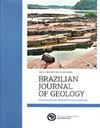Sequence stratigraphy of fluvial to shallow-marine deposits: The case of the early Permian Rio Bonito Formation, Paraná Basin, southernmost Brazil
IF 0.9
4区 地球科学
Q3 GEOSCIENCES, MULTIDISCIPLINARY
引用次数: 9
Abstract
This study presents new sedimentology data and attempts to understand coastal processes, sedimentary dynamics and stratigraphic patterns of the Rio Bonito Formation (early Permian) in Paraná Basin, southern Brazil. The study was performed based on the description of five cores, located in a small-scale area — São Gabriel City — in Rio Grande do Sul State, southern Brazil. Eighteen facies were described and grouped into nine facies associations. Later, these facies associations were then grouped into three depositional systems: fluvial, tide-dominated estuary and wave-dominated shallow-marine depositional systems. A paleoenvironmental evolution is proposed using three block diagrams showing the paleoenvironmental stage (S1, S2, and S3). S1 contains the oldest part of the sedimentary record with predominance of fluvial system deposits, S2 comprises dominantly estuarine system deposits, and S3 is mostly composed of shallow-marine deposits. Stratigraphic framework showed a general retrogradacional tendency, with thickness variations along the systems tracts that allowed for the construction of a curve of accommodation changes to the Rio Bonito Formation in the region of São Gabriel during the early Permian. This study contributes to a better understanding of the fluvial discharges, tidal and oscillatory (wave) currents and their interactions and dominances along stratigraphic records of coastal deposits.河流-浅海沉积的层序地层学:以巴西最南部帕拉南盆地早二叠世Rio Bonito组为例
本研究提供了新的沉积学数据,并试图了解巴西南部帕拉南盆地早二叠世Rio Bonito组的海岸过程、沉积动力学和地层模式。这项研究是基于对位于巴西南部南里奥格兰德州的一个小型地区—— o Gabriel市——的五个核心的描述进行的。18个相被描述并归类为9个相组。然后将这些相组合划分为3个沉积体系:河流沉积体系、潮汐沉积体系和波浪沉积体系。用三个方框图表示古环境阶段(S1、S2和S3),提出了古环境的演化过程。S1沉积记录最古老,以河流体系沉积为主,S2以河口体系沉积为主,S3以浅海沉积为主。地层格架表现出普遍的退向趋势,沿体系域的厚度变化使得构造出一条早二叠世时期 o Gabriel地区Rio Bonito组的可容纳性变化曲线。该研究有助于更好地了解沿海沉积地层记录的河流、潮汐和振荡(波)流及其相互作用和优势。
本文章由计算机程序翻译,如有差异,请以英文原文为准。
求助全文
约1分钟内获得全文
求助全文
来源期刊

Brazilian Journal of Geology
GEOSCIENCES, MULTIDISCIPLINARY-
CiteScore
3.20
自引率
7.10%
发文量
12
审稿时长
11 weeks
期刊介绍:
The Brazilian Journal of Geology (BJG) is a quarterly journal published by the Brazilian Geological Society with an electronic open access version that provides an in-ternacional medium for the publication of original scientific work of broad interest concerned with all aspects of the earth sciences in Brazil, South America, and Antarctica, in-cluding oceanic regions adjacent to these regions. The BJG publishes papers with a regional appeal and more than local significance in the fields of mineralogy, petrology, geochemistry, paleontology, sedimentology, stratigraphy, structural geology, tectonics, neotectonics, geophysics applied to geology, volcanology, metallogeny and mineral deposits, marine geology, glaciology, paleoclimatology, geochronology, biostratigraphy, engineering geology, hydrogeology, geological hazards and remote sensing, providing a niche for interdisciplinary work on regional geology and Earth history.
The BJG publishes articles (including review articles), rapid communications, articles with accelerated review processes, editorials, and discussions (brief, objective and concise comments on recent papers published in BJG with replies by authors).
Manuscripts must be written in English. Companion papers will not be accepted.
 求助内容:
求助内容: 应助结果提醒方式:
应助结果提醒方式:


